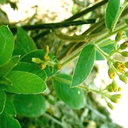Anti-hepatitis B virus effect and possible mechanism of action of 3,4-o-dicaffeoylquinic Acid in vitro and in vivo.
Từ khóa
trừu tượng
The anti-hepatitis B activity of 3,4-O-dicaffeoylquinic acid isolated from Laggera alata was studied using the D-galactosamine- (D-GalN-) induced hepatocyte damage model, HepG2.2.15 cells, and with HBV transgenic mice. In vitro results showed that 3,4-O-dicaffeoylquinic acid improved HL-7702 hepatocyte viability and markedly inhibited the production of HBsAg and HBeAg. At a concentration of 100 μg/mL, its inhibitory rates on the expression levels of HBsAg and HBeAg were 89.96% and 81.01%, respectively. The content of hepatitis B virus covalently closed circular DNA (HBV cccDNA) in HepG2.2.15 cells was significantly decreased after the cells were treated with the test compound. In addition, 3,4-O-dicaffeoylquinic acid significantly increased the expression of heme oxygenase-1 (HO-1) in HepG2.2.15 cells. In vivo results indicated that the test compound at concentrations of 100 μg/mL significantly inhibited HBsAg production and increased HO-1 expression in HBV transgenic mice. In conclusion, this study verifies the anti-hepatitis B activity of 3,4-O-dicaffeoylquinic acid. The upregulation of HO-1 may contribute to the anti-HBV effect of this compound by reducing the stability of the HBV core protein, which blocks the refill of nuclear HBV cccDNA. Furthermore, the hepatoprotective effect of this compound may be mediated through its antioxidative/anti-inflammatory properties and by the induction of HO-1 expression.



